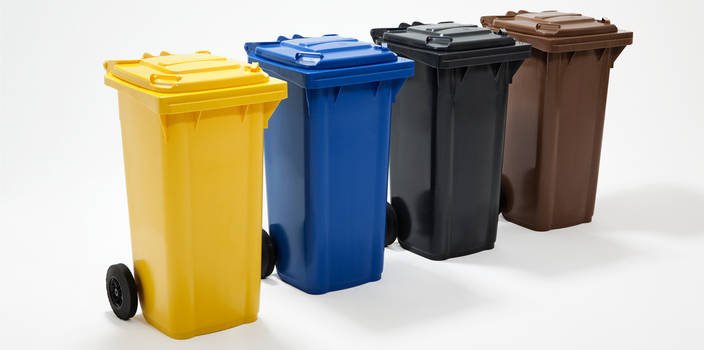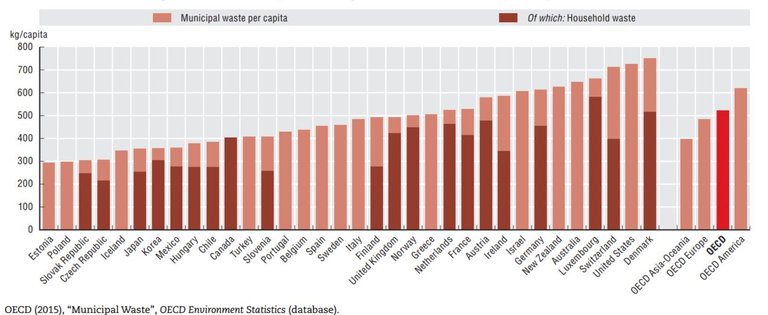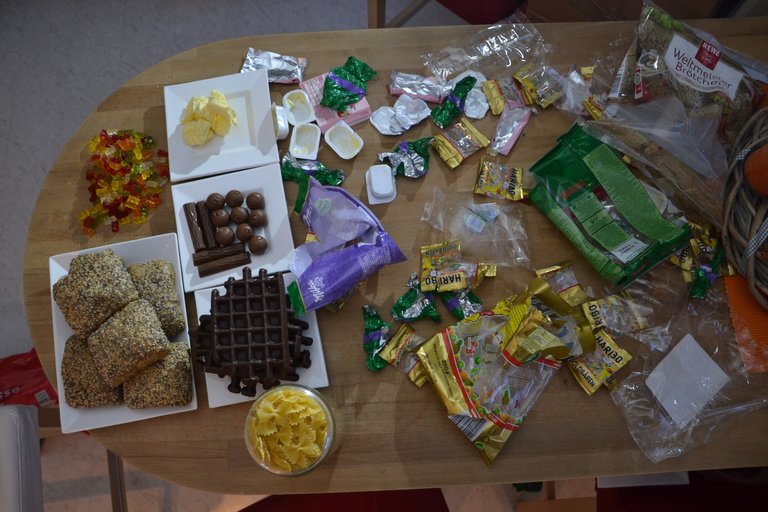There are three things that are sure:
1. … that death will get you sometime
2. … that you're on the better side of life with a Netflix account
3. … that every human on earth - without exception - produces waste
Putting death and Netflix aside for a moment …
A big part of world's population has got the possibility to separate their waste. Assigned trash cans and garbage collector companies makes this easier. But many people are not aware of how important waste separation really is. And this not only affects nationally, but also international.
Natural raw materials, like oil and ores are limited. And altough everyone knows it, far too few take an attempt to live less wasteful. Later more to that … Environmental pollution trough burned, but not recycled waste is getting more with growing population, altough there are new technologies. This is because of the still heavy usage of plastic like polypropylene (PP), polyethylene (PE), polyethylene terephtalate (PET). The plastic polypropylene (PP) is excusively produced out of oil. To produce 1000kg PET, the material which is used for plastic bottle manufacturing, there has to be expended 1900 litres of oil!! Far less harmful to the environment are container out of glass (main raw material quartz sand) and paper (mainraw material wood), that are proven to have a recycling quote of 80%. Based on these recycling quotes wastepaper can achieve a reusability factor of five. Recycled glass can even be reused up to ten times.
It is usually divided in seven waste fractions:
1. Glass, paper
2. Packagings out of plastic, aluminium, tinplate and composite materials
3. Bio waste
4. Pollutants
5. Electric scrap/cooling devices, metal scrap
6. C & D waste
7. Residual waste
Buying less wasteful
A progress that takes more and more place in supermarkets, ist the reduced use of plastic tote bags (consisting of PE). Since the introduction of chargeable bags, their commitment fell enormously. Only through the additional charge of 10 to 20 cents per bag, the usage of paper bags has increased by the factor of five. A progress for which the earth has waited too long.
But how can we reduce our waste without increased effort, but with the most use of it? A opportunity to this is the less wasteful buying of products. It happens much to often that we throw away expired food, because we didn't buy the demand-oriented quantity in advance. This issue can be avoided if you make a plan for a certain time frame. Buying mini or small-size packed products should also be avoided, because if not there's left much more plastic bags or waste than if you buy bigger, on your demand oriented packages. Just like I wrote above, it offers itself to use a paper or fabric bag. The advantage of fabric bags lies in the multiple usability. A rolled bag fits in so many places. To be sure to not forget one, you should stow some bags in the trunk of your car or at your bike. A shopping basket is another opportunity. With this one you could propably take your dog in it to the store (if allowed).
Due to the tactically applicated buying-psychology, which is succsessfully proven, almost all crisp and snack packages are not beeing used maximally. Everyone knows the comparison: A woman's bra is just like a bag of crisps, once you open it, you realize there's only the half of it. The inside is doubled optically, the one who buys it tends to grab the fully-looking bag. Thereby the material consumption and the plastic waste is doubled. Therefore it is advisable to not buy disposable products such as non refillable lighters, pens and one-way shavers. The same thing for beverage containers. Getting the own, closeable coffee mug filled up, instead of using a one-way cup. And buy refillable glass bottles. Reusability is the key word!
Almost 90% of the beverages, which are taken home in crates, bottles and cans are water. Simple solutions like Sodastream and/or a filtration system for tap water are a expensive purchase first, but in the long term you're gonna save a lot of money. A completely packaging-free alternative is buying products like fruits or vegetables on a weekend market. Not only that pounds of plastic waste is avoided, also the food on these kind of markets are always fresher and healthier than in a supermarket. Fair traded products are getting also more and more offered in supermarkets. And don't go shopping when you're hungry! At the end you'll go out of the store and bought more than you actually wanted. A shopping list is helpful and should be strictly followed. But if it happens that you buy a little bit too much, or just can't afford to eat it all before it expires, there's the possibility – if you got a refridgerator and it's ok for you – to freeze products like meat or fish, and consume it on another day.
Waste separation in germany – Numbers and facts
Because germany is my homeland, I decided to do research mainly for this country. Surprisingly I found out that in germany waste separation has been going on just since 1991. The first number I could find was the number of plastic manufacturing. Approximately 10 million tons per year → That are 10 000 000 000 kilogramms!!!!! 4 million tons of this consist of packaging. 0,8 million tons of that got the green point (labeling system for waste separation across europe). Finally 60% of that number is beeing collected and only 1/3 of this amount is beeing recycled at the end. That's only 160 000 kilogramms out of 10 million tons.
It would be wrong to assume that a new yogurt cup is made out of a recycled one. Flowerpots or park benches are just a few examples of what recycled plastic is made. This process is called downcycling, because the end product does not have the same quality as the original one. These plastic packagings are beeing transportated on an average of 300 kilometres through the country. Because of the additional charge on every packaging that is marked with the green point, clients must pay approximately 1,5 billion euros more annually. These charges are there to pay royalties. This money goes to the organizers of the waste separation process. One of the biggest in this business in germany is the Duale System Deutschland GmbH (DSD). Imagine that: 1 ton of PE- or PP- packagings got a market value of 200€ to 350€. Aluminum up to 1000€ and PET-bottles up to 400€ per ton. What only few know: Shredded PET-bottles are beeing sold to big companies in china and then melted as a secondary raw material to produce weaved polyester thread*. Almost all imported fleece-sweater are made of this. Out of shredded PET-bottles.
*Greenpeace in asia estimates that these polyester threads are the half of the whole PET-bottle import.

The waste separation system in germany has their deviations beneath the federal states, but is mainly the same:
- Yellow trashcan/yellow bag → Plastic waste: plastic, composite materials, aluminum, sheets, foam materials, etc.
- Black trashcan → Residual waste: cigarettes, light bulbs, condoms, leather residues, etc.
- Brown trashcan → Bio waste: kitchen waste, bones, meat, fruit- and vegetable waste, leaves, flowers, etc.
- Blue trashcan → Paper waste: newspapers, cardboard, paper packagings, books, magazines, etc.
The waste scientist Klaus Wiemer introduced against this a new concept with only two trashcans, not four => one for wet, and one for dry waste. That's because almost 50% of garbage lands in the wrong trashcan. Thus the dry waste could easily be separated and the wet one could be used for energy extraction, for example via biogas. Michael Braungart, CEO of the 'Environmental Protection Encouragement Agency' (EPEA), gives food for thought: „We should think in nutrient, not in garbage. Almost 13% of germany's waste is beeing burnt without using it for energy extraction.“
The situation in other countries
Investigations by the OECD (Organisation for Economic Co-operation and Development) about environmental behavior in 34 other member states, revealed that Switzerland, Belgium, Denmark, Sweden, Norway, the Netherlands, Austria and Japan do recycle more than germany. 46% of the whole waste in the OECD-area are simply deposited without any benefit. And although the whole garbage volume fell since 2000 by 30kg per head, OECD recorded a waste quote of 520kg on average per person.

Further shocking numbers
- More than 90% of the population in the OECD-states are being harmed by particulate matter
- The average citizen in OECD-countries generates per head about 9,6 tons of CO2-emissions, while in the rest of the world the number per person is 3,4 tons
- Almost 0% of the garbage in Bulgaria is being recycled
- In 2011 approximately 4000 tons of waste remained on the streets of Naples, Italy due to strikes
- 600 000 tons of electric scrap are getting thrown away in germany annually
But there's also good news
The amount of regenerative energies in electricity production has risen from 15,6% in 2000 to current 21%. Austria is one of the top leaders with 63% at the recycling quote according to European Environment Agency (EEA). The same quote has risen in Great Britain from 12% to 39% and in Ireland from 11% to 36%. Environmental pollution due to not recycled waste
1,3 billion tons of food spoil every year on the whole world!!! → 1,300 000 000 000 kilogramms That's 1/3 of the worldwide food production
The raw material costs of the german industry are at about 130 billion euro. These accompanied environmental pollutions have a great impact on the habitat of many animals. The fertility of fish decreases by pesticides like Aclonifen, Dioxin and drugs like Diclofenac and E22. Scientist from the United Nations counted 25 million cigarette filters in a marine investigation. Per square meter of the oceans, there swims about 46000 pieces of plastic waste. 60 million tons of plastic are being manufactured in the EU in one year; that's ¼ of world's production of 265 million tons in 2011. But to gather resources, there's too much of raw materials mined than recycled. To gather 1 ton of copper, you need to mine an amount of 1000 tons of rock → or easier: recycle an amount of 14 tons of electric scrap. 800 000 litres of sewage are being produced in just one week on a cruise ship, thereof 13000 litres of oleaginous water. German research centers say that until 2025 there will be more than 6 million tons of set waste – this would be enough to build a 5000km long line of filled garbage cars.

Conclusion
The world how we know it soon won't exist anymore. Not if we continue like that. Wie hear it every day: The world is in danger, we are all going to be dead. No one is doing something so I won't either and so on… But the solution for this issue starts with you. Pay attention on your next shopping routine what you are actually buying and if you really can use this all up in two weeks. Pay attention what you throw in the residual waste. Pay attention how you treat the environment. Because you have the privilege to live here, so care about your habitat.
These issues do not occur the first time …
… we've just ignored them over and over again.
I'm trying to get better in english translating, hope you understand everything.
